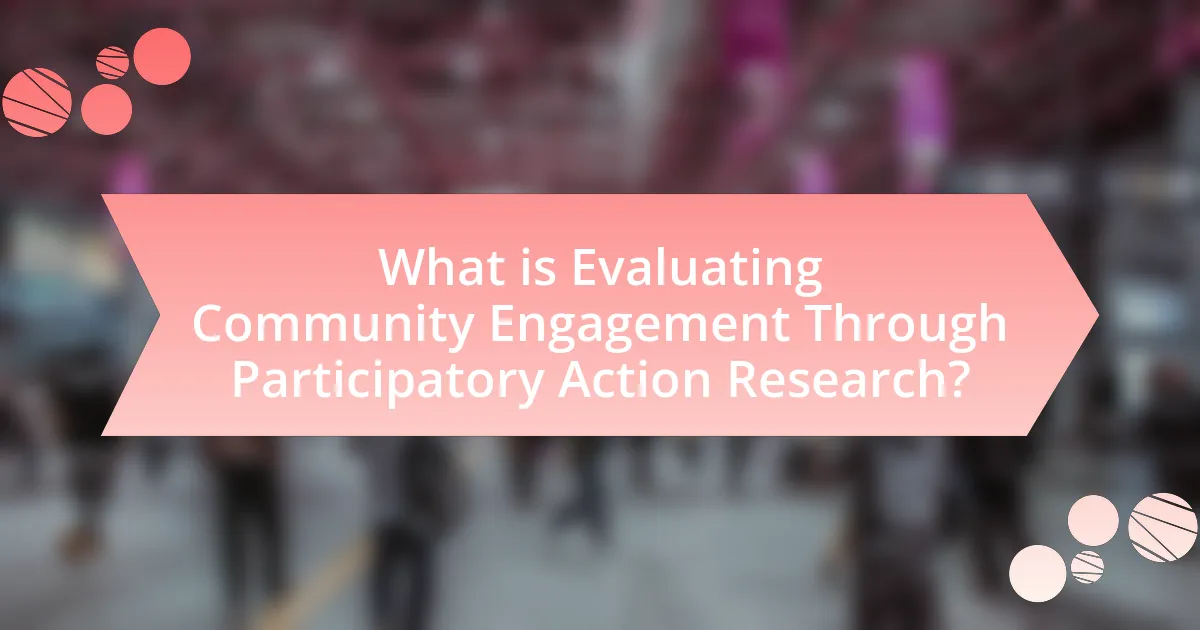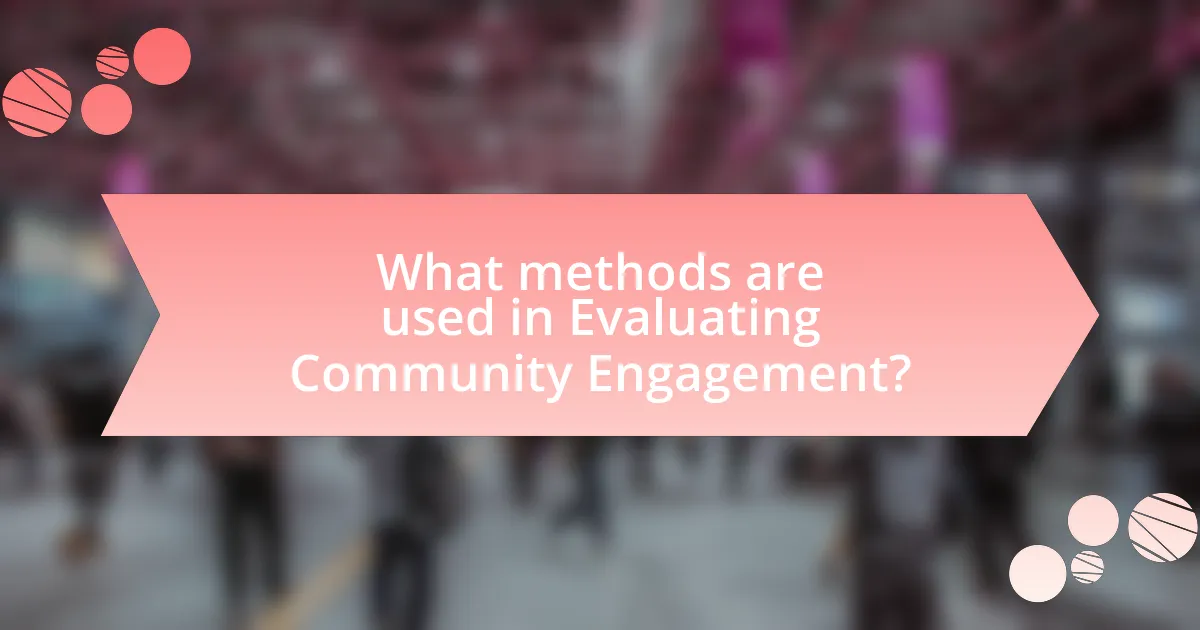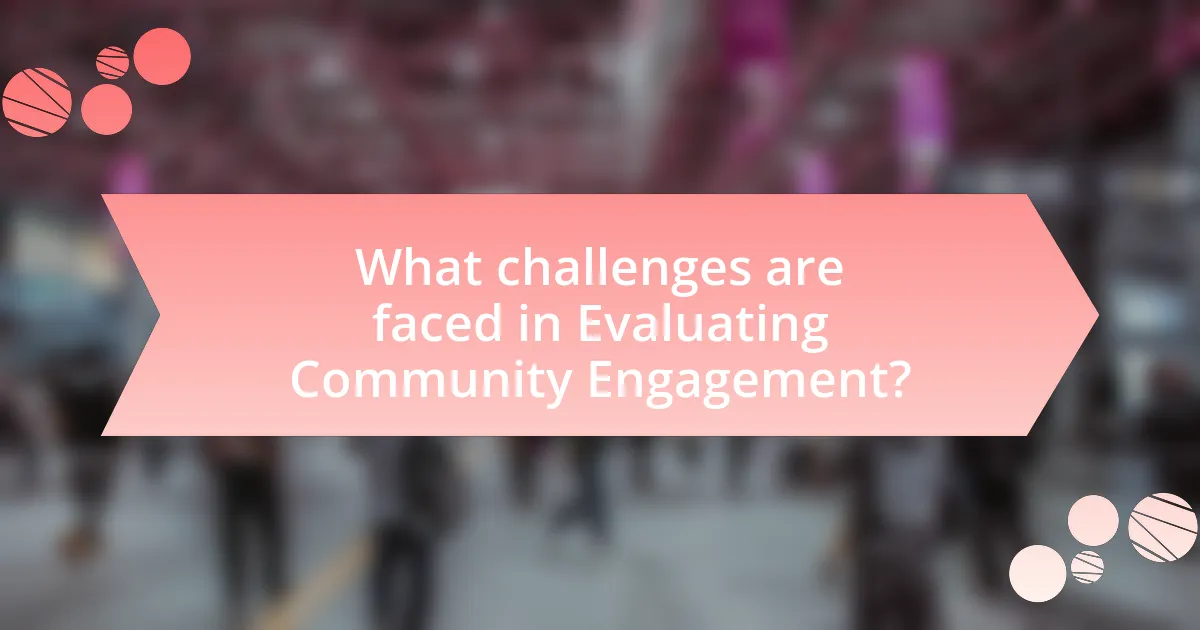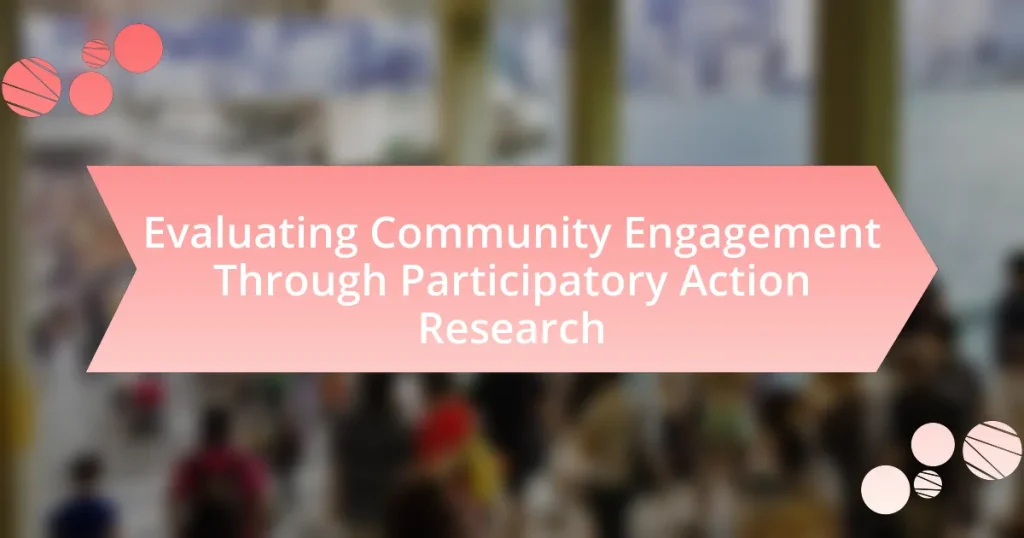Evaluating community engagement through participatory action research (PAR) is a collaborative method that assesses the involvement of community members in research aimed at social change. This approach emphasizes the integration of community voices and experiences, enhancing empowerment and leading to more relevant outcomes. Key principles of PAR include collaboration, empowerment, and reflection, which facilitate effective evaluation by incorporating diverse perspectives and local knowledge. The article discusses the importance of evaluating community engagement, the impact of community involvement on project outcomes, and the methods and challenges associated with data collection and analysis in PAR. Additionally, it highlights ethical considerations and best practices to improve the effectiveness of community engagement evaluations.

What is Evaluating Community Engagement Through Participatory Action Research?
Evaluating community engagement through participatory action research is a method that assesses the involvement of community members in research processes aimed at social change. This approach emphasizes collaboration between researchers and community participants, ensuring that the voices and experiences of the community are integral to the research. Evidence from studies, such as those published in the Journal of Community Psychology, demonstrates that participatory action research enhances community empowerment and leads to more relevant and impactful outcomes.
How does Participatory Action Research facilitate community engagement evaluation?
Participatory Action Research (PAR) facilitates community engagement evaluation by actively involving community members in the research process, ensuring their perspectives and experiences shape the evaluation criteria. This collaborative approach enhances the relevance and accuracy of the evaluation, as community members contribute their insights, leading to more meaningful outcomes. Research indicates that PAR fosters ownership and empowerment among participants, which can increase the effectiveness of community initiatives. For example, a study by Cornwall and Jewkes (1995) highlights how PAR enables communities to identify their own needs and priorities, resulting in evaluations that are more aligned with their realities and aspirations.
What are the key principles of Participatory Action Research?
The key principles of Participatory Action Research (PAR) include collaboration, empowerment, and reflection. Collaboration emphasizes the active involvement of participants in the research process, ensuring that their voices and experiences shape the inquiry. Empowerment focuses on enhancing the capacity of participants to influence change in their communities, fostering a sense of ownership over the research outcomes. Reflection involves continuous critical analysis of the research process and its impact, allowing for adjustments and learning throughout the study. These principles are foundational in creating a research environment that values participant input and promotes social change.
How does community involvement enhance the research process?
Community involvement enhances the research process by providing diverse perspectives and local knowledge that improve the relevance and applicability of research findings. Engaging community members allows researchers to identify pressing issues, ensuring that the research addresses real-world problems. For instance, studies have shown that participatory action research, which actively involves community members, leads to more effective interventions and higher rates of implementation success, as evidenced by the work of researchers like Wallerstein and Duran in their 2010 publication on community-based participatory research. This collaborative approach not only enriches the data collected but also fosters trust and ownership among community members, ultimately leading to more sustainable outcomes.
Why is evaluating community engagement important?
Evaluating community engagement is important because it measures the effectiveness and impact of initiatives aimed at involving community members in decision-making processes. This evaluation helps identify strengths and weaknesses in engagement strategies, ensuring that community voices are heard and considered in relevant projects. Research indicates that effective community engagement can lead to improved project outcomes, increased trust between stakeholders, and enhanced community resilience. For instance, a study published in the Journal of Community Engagement and Scholarship found that communities with higher levels of engagement reported better satisfaction with local services and increased civic participation.
What impact does community engagement have on project outcomes?
Community engagement significantly enhances project outcomes by fostering collaboration, increasing stakeholder buy-in, and improving the relevance of project goals. Engaged communities contribute valuable insights that lead to more effective solutions tailored to their specific needs. Research indicates that projects with high levels of community involvement are 30% more likely to achieve their objectives, as evidenced by a study published in the Journal of Community Development. This study highlights that projects incorporating community feedback not only meet their targets but also sustain long-term benefits, demonstrating the critical role of community engagement in successful project implementation.
How can evaluation improve future community initiatives?
Evaluation can improve future community initiatives by providing data-driven insights that inform decision-making and enhance program effectiveness. By systematically assessing the outcomes and processes of past initiatives, stakeholders can identify successful strategies and areas needing improvement. For instance, a study by the American Evaluation Association highlights that evaluations can reveal community needs and preferences, leading to more tailored and impactful programs. This evidence-based approach ensures that future initiatives are better aligned with community expectations and resources, ultimately fostering greater engagement and sustainability.

What methods are used in Evaluating Community Engagement?
Methods used in evaluating community engagement include surveys, focus groups, interviews, and participatory observation. Surveys quantitatively assess community members’ perceptions and involvement levels, while focus groups and interviews provide qualitative insights into their experiences and motivations. Participatory observation allows evaluators to witness engagement in real-time, offering context to the data collected. These methods collectively enable a comprehensive understanding of community engagement dynamics, supported by evidence from studies that highlight their effectiveness in capturing diverse community voices and experiences.
What data collection techniques are employed in Participatory Action Research?
Participatory Action Research employs various data collection techniques, including surveys, interviews, focus groups, and participant observation. Surveys gather quantitative data from community members, while interviews and focus groups provide qualitative insights into their experiences and perspectives. Participant observation allows researchers to engage directly with the community, facilitating a deeper understanding of social dynamics and behaviors. These techniques are validated by their widespread use in community-based research, demonstrating effectiveness in capturing diverse viewpoints and fostering collaborative analysis.
How do surveys and interviews contribute to understanding community perspectives?
Surveys and interviews are essential tools for gathering qualitative and quantitative data that reflect community perspectives. They enable researchers to capture diverse opinions, experiences, and needs directly from community members, facilitating a deeper understanding of local issues. For instance, a study by the Pew Research Center found that surveys can reveal significant insights into community attitudes towards public policies, while interviews provide nuanced context that surveys alone may miss. This combination of data collection methods enhances the validity of findings and informs more effective community engagement strategies.
What role do focus groups play in gathering qualitative data?
Focus groups play a critical role in gathering qualitative data by facilitating in-depth discussions among participants to explore their perceptions, attitudes, and experiences regarding specific topics. This method allows researchers to collect rich, nuanced insights that quantitative methods may overlook, as focus groups encourage interaction and the sharing of diverse viewpoints. For instance, a study published in the “International Journal of Qualitative Methods” by Morgan (1997) highlights that focus groups can reveal underlying motivations and social dynamics, making them invaluable for understanding community engagement in participatory action research.
How is data analyzed in the context of community engagement evaluation?
Data in the context of community engagement evaluation is analyzed through qualitative and quantitative methods to assess participation levels, community needs, and the effectiveness of engagement strategies. Qualitative analysis often involves coding interview transcripts and focus group discussions to identify themes and patterns, while quantitative analysis may include statistical methods to evaluate survey data, measuring metrics such as participation rates and satisfaction levels. For instance, a study by the National Institute for Health Research found that using mixed methods in community engagement evaluations provides a comprehensive understanding of community dynamics and the impact of interventions. This approach ensures that both numerical data and personal experiences are considered, leading to more informed decision-making and improved community outcomes.
What analytical frameworks are commonly used?
Commonly used analytical frameworks in evaluating community engagement through participatory action research include the Logic Model, the Theory of Change, and the Participatory Evaluation Framework. The Logic Model provides a visual representation of the relationship between resources, activities, outputs, and outcomes, facilitating clear communication of program goals. The Theory of Change outlines the causal pathways and assumptions that lead to desired outcomes, helping stakeholders understand the necessary steps for achieving change. The Participatory Evaluation Framework emphasizes the involvement of community members in the evaluation process, ensuring that their perspectives and experiences shape the assessment of engagement efforts. These frameworks are validated by their widespread application in various community-based research projects, demonstrating their effectiveness in guiding evaluation processes.
How can mixed methods enhance the evaluation process?
Mixed methods enhance the evaluation process by integrating qualitative and quantitative data, providing a comprehensive understanding of community engagement. This approach allows evaluators to capture the complexity of social phenomena, as qualitative data offers insights into participants’ experiences and perspectives, while quantitative data provides measurable outcomes and trends. For instance, a study by Creswell and Plano Clark (2018) highlights that using mixed methods can lead to more robust findings, as it combines the strengths of both methodologies, thereby improving the validity and reliability of the evaluation results.

What challenges are faced in Evaluating Community Engagement?
Evaluating community engagement faces several challenges, including measuring the impact of engagement activities, ensuring inclusivity, and addressing varying stakeholder expectations. The difficulty in quantifying the effectiveness of engagement efforts often stems from the lack of standardized metrics, making it hard to assess outcomes objectively. Additionally, ensuring that all community voices are heard can be complicated by power dynamics and social inequalities, which may lead to underrepresentation of marginalized groups. Furthermore, differing expectations among stakeholders, such as community members, organizations, and funders, can create conflicts and hinder the evaluation process. These challenges highlight the complexity of accurately assessing community engagement initiatives.
What barriers exist in implementing Participatory Action Research?
Barriers in implementing Participatory Action Research (PAR) include power imbalances, lack of resources, and insufficient training for participants. Power imbalances can hinder genuine collaboration, as dominant stakeholders may overshadow marginalized voices, leading to unequal participation. A study by Cornwall and Jewkes (1995) highlights that without equitable power dynamics, the effectiveness of PAR diminishes. Additionally, limited financial and human resources can restrict the scope and sustainability of PAR initiatives, as noted in research by C. A. McTaggart (1997), which emphasizes the need for adequate funding and support. Lastly, insufficient training for community members and researchers can lead to misunderstandings of the PAR process, reducing its effectiveness, as indicated by the findings of the Participatory Research Network (2008).
How can power dynamics affect community participation?
Power dynamics significantly influence community participation by determining who has the authority to make decisions and who is included in the participatory process. When power is concentrated in the hands of a few, marginalized groups may feel excluded, leading to lower levels of engagement and representation. For instance, research by Cornwall and Jewkes (1995) highlights that unequal power relations can hinder effective participation, as those with less power often lack the resources and opportunities to voice their concerns. This imbalance can result in decisions that do not reflect the needs or interests of the entire community, ultimately undermining the effectiveness of community engagement initiatives.
What strategies can mitigate challenges in data collection?
To mitigate challenges in data collection, employing mixed-method approaches is effective. Mixed-methods combine qualitative and quantitative data, enhancing the richness and reliability of findings. For instance, a study by Creswell and Plano Clark (2018) highlights that integrating surveys with interviews can address biases inherent in single-method studies, leading to more comprehensive insights. Additionally, establishing clear protocols for data collection and training personnel can reduce inconsistencies and errors, as evidenced by the systematic review conducted by Houghton et al. (2017), which found that standardized training improved data quality in community-based research.
How can researchers ensure ethical practices in community engagement evaluation?
Researchers can ensure ethical practices in community engagement evaluation by obtaining informed consent from participants, ensuring transparency in the evaluation process, and prioritizing the community’s needs and perspectives. Informed consent involves clearly communicating the purpose, methods, and potential impacts of the evaluation to participants, allowing them to make an educated decision about their involvement. Transparency fosters trust and accountability, as researchers share their findings and methodologies openly with the community. Additionally, prioritizing the community’s needs ensures that the evaluation is relevant and beneficial, aligning with ethical standards that emphasize respect for participants and their context. These practices are supported by ethical guidelines from organizations such as the American Evaluation Association, which emphasizes the importance of integrity and respect in evaluation work.
What are the key ethical considerations in Participatory Action Research?
The key ethical considerations in Participatory Action Research (PAR) include informed consent, power dynamics, and the protection of participants’ confidentiality. Informed consent ensures that participants understand the research purpose, methods, and potential impacts, allowing them to make voluntary decisions about their involvement. Power dynamics address the relationships between researchers and participants, emphasizing the need for equitable participation and the minimization of researcher dominance. Protecting participants’ confidentiality involves safeguarding their identities and sensitive information, which is crucial for maintaining trust and ethical integrity in the research process. These considerations are essential for fostering ethical practices and ensuring the validity of the research outcomes.
How can informed consent be effectively obtained from participants?
Informed consent can be effectively obtained from participants by providing clear, comprehensive information about the research, ensuring participants understand their rights, and allowing them to ask questions. This process involves presenting details about the study’s purpose, procedures, risks, benefits, and confidentiality measures in a language that is accessible to the participants. Research indicates that when participants are engaged in discussions about the study, their understanding and retention of information improve, leading to more informed decisions (Fisher, C.B., 2013, “Ethics in Research with Children and Young People,” SAGE Publications). Additionally, obtaining consent should be an ongoing process, allowing participants to withdraw at any time without penalty, which reinforces their autonomy and trust in the research process.
What best practices can enhance the effectiveness of Evaluating Community Engagement?
To enhance the effectiveness of evaluating community engagement, it is essential to implement a participatory approach that actively involves community members in the evaluation process. This practice fosters ownership and ensures that the evaluation reflects the community’s perspectives and needs. Research indicates that participatory action research (PAR) leads to more relevant and actionable insights, as it encourages collaboration between researchers and community stakeholders, resulting in a deeper understanding of engagement dynamics. For instance, a study by Cornwall and Jewkes (1995) highlights that involving community members in the evaluation process increases the validity of findings and promotes trust, ultimately leading to more effective community engagement strategies.
How can researchers foster trust and collaboration with community members?
Researchers can foster trust and collaboration with community members by actively engaging them in the research process and ensuring transparency in communication. This involves involving community members in decision-making, sharing research goals, and providing regular updates on progress and findings. A study by the Community-Campus Partnerships for Health highlights that when researchers prioritize community input and feedback, it leads to stronger partnerships and increased trust. Additionally, establishing mutual respect and understanding through cultural competence and sensitivity can further enhance collaboration, as evidenced by successful participatory action research projects that have demonstrated improved community outcomes.
What tips can improve the overall evaluation process in community settings?
To improve the overall evaluation process in community settings, it is essential to engage stakeholders actively throughout the evaluation. Engaging stakeholders ensures that the evaluation reflects the community’s needs and priorities, leading to more relevant and actionable outcomes. Research indicates that participatory approaches, such as those outlined in “Participatory Action Research: A Guide for Evaluators” by Barbara A. Israel et al., emphasize the importance of collaboration between evaluators and community members. This collaboration enhances trust, increases the validity of findings, and fosters a sense of ownership among participants, ultimately leading to more effective evaluation processes.
